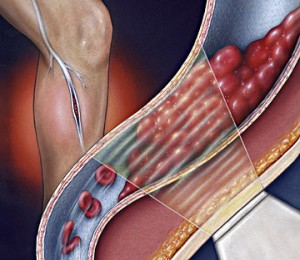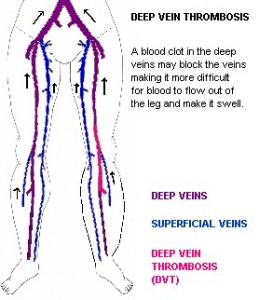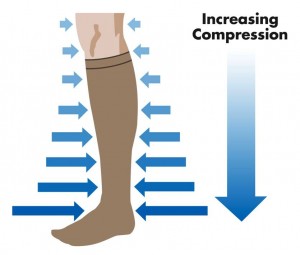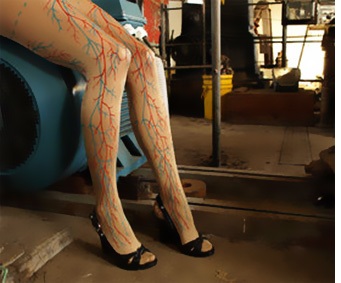Varicose vein and deep vein thrombosis are two diseases that are often heard or read in news or magazines. Obviously, they are both diseases of the vein. But what exactly are they? What are the differences between these two venous conditions? Veins carry blood from the circulation back to the heart to be exchanged for oxygen. Due to gravity, pooling of blood at lower parts of the body, such as the feet, can occur. Hence, frequent and long duration of standing or immobilization of the legs is likely to cause development of varicose vein or deep vein thrombosis, depending on which vein is involved.
 Varicose Veins
Varicose Veins
This condition involves the superficial veins in the body. It is commonly seen as enlarged, tortuous veins over the feet, calf or behind the knee. Unlike the arteries, veins have valves. These valves are required to pump deoxygenated blood from the circulation against gravity back to the heart. When these valves become incompetent, blood is unable to overcome gravity and instead refluxes back into the congested area. The venous valves are one-way valve to ensure blood flows back to only one direction, i.e. back to the heart. Thus, weakening of the valves due to advance age, obesity or hormonal changes results in venous insufficiency.
 Causes
Causes
- Advancing age – as one gets older, the valves in the veins becomes weaker due to loss of elasticity of the veins
- Pregnancy – during pregnancy, hormonal changes and high blood volume in the body contributes to developing varicose veins
- Sex – unfortunately for the ladies, female are more likely to have varicose veins compared to men
Signs and symptoms of varicose veins
- Pain – usually absent but in severe cases can be present
- Bulging and twisted vein seen
- Bluish or purplish color of the vein that is obvious and distinct on the skin
Treatment Options

- Lose weight and elevate legs when sleeping can help improve blood circulation
- The use of compression stockings is the first-line treatment. The tight elasticity of the stockings help to squeeze blood back to the heart
- Surgically, there are a few options ranging from laser therapy to vein stripping. Although surgery is for cosmetic purpose, it is also advisable for patients who do not see improvement from conservative care
Complications
If the varicose veins are left alone and not dealt with at all, certain complications below can develop.
- Stasis eczema
- Venous ulcer
- Venous thromboembolism
- Variceal bleeding
 Deep Vein Thrombosis (DVT)
Deep Vein Thrombosis (DVT)
This is a type of venous thromboembolism, i.e. an occlusion in the vein due to a blood clot. In contrary with varicose veins, as the name suggests, deep vein thrombosis involve the deep veins which are enclosed between muscles, not seen by the eye underneath the skin like the superficial ones.
It is commonly known that long haul flights cause DVT and the possible reasons are listed below. DVT can be potentially life threatening because of the possibility of the blood clot to break off from the original site and lodge in other parts, e.g. the blood vessels in the lungs, causing a dangerous condition called pulmonary embolism. Â One of the commonest sites of DVT is in the legs. If the DVT is located in below the knee, i.e. the distal part of the leg, there is 5% chance of developing pulmonary embolism. On the other hand, if it is located above the knee, i.e. the proximal part, there is 50% of such risk.
 Causes
Causes
Deep vein thrombosis occurs due to few reasons:
- Venous stasis – slow rate or obstruction to blood flow
- Damage of the vein
- Hypercoagulibility of blood – Increase thickness of blood
Signs and symptoms
DVT can occur anywhere in the arms or legs. Most commonly it is located in the leg. DVT causes inflammation too, hence causing the following:

- Pain – this can be demonstrated or aggravated by flexing the ankleupwards (Homan’s sign)
- Swelling
- Redness or discoloration
- Warmth
Aside from the signs and symptoms mentioned above, it is important to recognize those of pulmonary embolism as this is a medical emergency. These signs and symptoms include:
- Sudden onset of shortness of breath
- Chest discomfort upon breathing
- Coughing up blood
- Sense of impending doom
Diagnosis
- Duplex ultrasonography
- Blood test – Coagulation profile, D-dimer test
- Venography
- Magnetic Resonance Imaging (MRI)
Treatment Options
- Compression stockings – useful in long haul flights or occupational
- Anticoagulant medications – aspirin, enoxaprin, warfarin
Complications
- Pulmonary embolism
- Skin discoloration
- Venous ulceration
Most DVT or small clots resolves spontaneously without the occurrence of any complication. Nonetheless, it is advisable to visit a doctor for such assurance. Especially when signs and symptoms of pulmonary embolism are suspected, do not delay to seek medical help.

